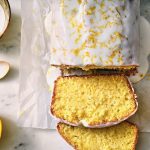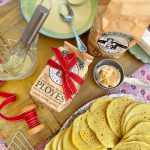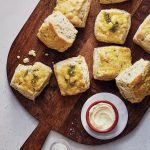Portuguese Sweet Bread
Rich and sweet, this “Massa Suvada,” or Portuguese Sweet Bread, is traditional Portuguese Easter recipe, with the eggs symbolizing new life.
My grandmother, Mary Grace Deschenes, was an unusual woman for her day. An accomplished artist, she studied at Pratt Institute in New York in the early 1900s, eventually returning to her native New Bedford, Massachusetts, where she married and had her only child, my father.
As a little girl, I often visited Gramma at her home at 563 Dartmouth Street, the oldest house in South Dartmouth. There was a big, old-fashioned kitchen with a painted wooden table, and the whole place was full of brightly colored china, nautical decorations, and my grandmother’s paintings.The luscious smell of Sweet Bread in the oven and Soupash (Portuguese Kale Soup) on the stove was as certain as a big hug on my way in the door. Luckily for me, I inherited both her artistic talent and her recipes for these authentic Portuguese foods.
“Massa Suvada,” or Portuguese Sweet Bread, is traditionally served on Easter, with the eggs symbolizing new life in the Resurrection. Sometimes a whole egg is actually baked into the bottom of the loaf. We had it hot out of the oven, then toasted on a fancy wire toaster that looked like a four-sided pyramid. This bread is too good to eat only once a year. –Debbie Schradieck, Westborough, Massachusetts
Yield:
Ingredients
1 cup whole milk
1 cup granulated sugar
1/2 cup unsalted butter (not shortening)
1-1/2 teaspoons salt
1 envelope yeast
4 large eggs, beaten
1/2 teaspoon mace
1/2 teaspoon lemon extract (optional)
5 to 6 cups all-purpose flour
Instructions
Scald the milk. Add the sugar, butter, and salt. Stir until butter melts and sugar dissolves. Cool.
Dissolve the yeast in 1/4 cup warm water. Add to cooled milk mixture. Transfer to large bowl. Add the beaten eggs, mace, and lemon extract, if using; stir in enough flour to form a cohesive dough. Dough should be firm and only slightly sticky.
Turn the dough onto floured surface and knead until smooth and elastic. When it’s a round ball and feels as smooth as a baby’s behind, it’s OK.
Place dough in a greased bowl covered with waxed paper and a clean cloth. Let rise double slowly, 3 to 4 hours in a cool place, or overnight in the refrigerator.
When the dough is well risen, punch down, re-cover, and let rise again, 1-1/2 to 2 hours.
Punch down again, shape 2 loaves, and place in greased pans or on greased sheet. Cover and let rise double, about 1 hour.
Bake at 400 degrees F for 10 minutes, then reduce heat to 375 degrees F and bake until loaves are well browned and sound hollow when tapped, 35 to 40 minutes. Cool on rack.








We used to get this kind of bread many years ago in Seekonk, Massachusetts, from our Portugeuse friends. Gave some of it to our Portugeuse friend here in Manchester, and we all pronounced it GREAT.
Excellent bread. A special treat when I make it for my family.
My mother in-law gave me this recipe, but made it festive for Christmas. After you separate the dough into 2 loaves, break the dough into 4 parts. Shape 3 of them into strands 14 inches long. Place on a greased cookie sheet and braid loosely, fastening ends. With the 4th part, divide into 3 parts and make 3 strands, 12 inches long. Make a second braid and place on top of large braid. Cover and let rise. Bake as directed in the recipe above. After they are cooked and cooled, frost with a thin icing and decorate with cherries and colored fruit(the kind you use to make a fruit cake). We call this “Christmas Braid”.
The timing on the recipe is definitely off. While 10 minutes at 400 and 35 at 375 may yield a fully baked loaf, the crust will be finished in a matter of 15, with smell, texture, and sound indicating that the loaf is most likely done. Better to start with a lower heat and maintain it throughout (35-45 at 325-350 perhaps; I’ll have a better idea when I bake another batch). Also, I used 6 cups of flour, not 5. Otherwise, flavor, crumb, and crust all came out nicely.
I’m from New Bedford. My grandfather owned Lupo’s Bar and Grill. We lived for a while on Dartmouth St. I love this bread. My mom would make Portuguese Kale soup and this bread. Brings back wonderful memories of New Bedford and my grandparents.
I had an aunt from East Providence R I that taught me to make the bread, she also showed me the wedding ring bread. I made two of them years ago and now my granddaughter is marrying and I can’t seem to remember how it looks other than made into a ring please help if you can. Thank you